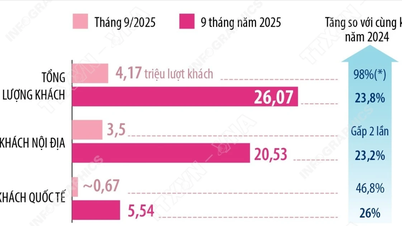According to the latest report released by the United Nations Tourism Organization (UN Tourism), the number of global tourist arrivals in the first 6 months of the year increased by 5% (compared to the same period in 2024) and is about 4% higher than the pre-pandemic level. Nearly 690 million international visitors traveled around the world from January to June 2025, 33 million more than the same period in 2024.
The strongest increases were recorded in Japan and Vietnam, up 21%, followed by Morocco up 19%, South Korea up 15%, Malaysia and Indonesia both up 9%.
UN Tourism Secretary-General Zurab Pololikashvili said: “Despite global challenges, international tourism remains strong and resilient.
The first half of 2025 will see growth in arrivals and revenues in most destinations around the world, contributing to local economies , creating jobs and livelihoods. However, this also reminds us of the great responsibility to ensure this growth is sustainable and inclusive, and to work with local stakeholders.”
Tourism revenue increased sharply
According to information from the National Tourism Administration, the latest publication of the World Tourism Barometer, which assesses the performance of the tourism industry by region in the first 6 months of this year, shows that Africa has the strongest growth of 14%, while Asia-Pacific continues to recover.
Asia-Pacific increased by 11%, reaching 92% of pre-pandemic levels (still 8% lower than 2019). Northeast Asia increased the most with 20%, although still 8% lower than 2019. Among the destinations with the highest growth include: Japan and Vietnam (21%), South Korea (15%), Morocco (19%), Mexico and the Netherlands (7%). The three markets of Malaysia and Indonesia (9%), Hong Kong (China) (7%) increased but the number of arrivals is still lower than the same period in 2019 before the pandemic.

In addition, Europe will welcome nearly 340 million international visitors, up 4% from 2024 and 7% from 2019. Northern Europe, Western Europe and the Southern Mediterranean will increase by 3%. Central and Eastern Europe will recover strongly with 9% but still 11% lower than 2019.
The Americas grew by 3%, but subregions had mixed results. South America grew strongly by 14%, Central America by 2%, and North America by 0%, as arrivals to the US and Canada fell slightly. The Caribbean also did not grow due to a decline in demand for travel from the US.
The Middle East, although down 4% year-on-year in 2024, is still 29% higher than in 2019 before the pandemic. The world's top destinations also recorded growth, with France and Spain both up 5%.
According to IATA (International Air Transport Association), international air traffic and seat capacity both increase by 7% in the period January-June 2025 compared to the same period in 2024. Global hotel occupancy rates reach 69% of capacity in June 2025 (compared to 70% in June 2024) and 71% in July (equivalent to 2024).
International tourism receipts increased strongly in major destinations: Japan (up 18%), UK (up 13% from January to March), France (up 9%), Spain (up 8%), Turkey (up 8%).

In 2024, international tourism receipts are expected to increase by 11% to a record US$1,734 billion, 14% higher than before the pandemic (in real terms), reflecting strong spending by tourists worldwide.
How will tourism confidence be at the end of the year?
As in previous surveys, the September survey results from the Council of Travel Experts and the UN Travel Confidence Index show that high transport and accommodation costs, along with macroeconomic factors, continue to be the two biggest challenges for international tourism in 2025.
According to the travel inflation estimation method, the figure is forecast to decrease from 8% in 2024 to 6.8% in 2025, which is still significantly higher than the pre-pandemic level (3.1%) and the general global inflation (4.3%).
According to the Council, tourists are expected to pay more attention to the value received, tend to choose closer destinations, shorten their stay or reduce spending to cope with rising prices.
In addition, uncertainty from economic and geopolitical tensions also directly impacts travel confidence. Weak consumer confidence was ranked as the third biggest impact factor in the September 2025 survey, followed by geopolitical risks (other than ongoing conflicts) in fourth place. Increased trade tariffs (ranked 5th) and travel restrictions (ranked 6th) were also significant concerns raised by the Expert Panel.

The latest United Nations Global Travel Confidence Index shows a slight improvement in the last four months of 2025. On a scale of 0-200 (where 100 reflects the same level of performance - no better and no worse), the Council's experts scored the September-December 2025 period at 120 points, up from 114 points in the May-August period.
About half of the experts surveyed expressed more positive expectations for the period, with 44% predicting “better” results and 6% believing it will be “much better.” 33% said tourism results will be similar to 2024, while only 16% predicted a decline.
This optimistic but cautious outlook is also reinforced by an increase in the proportion of “better” and “much better” assessments for all of 2025, reaching 60% in the September survey, compared with 49% in May.
Despite global uncertainties, international tourism demand is expected to remain resilient in the remaining months of the year. UN Tourism maintains its forecast of international arrivals growth of 3-5% in 2025./.
Source: https://www.vietnamplus.vn/du-lich-viet-nam-tang-truong-cao-nhat-bat-chap-nhung-thach-thuc-toan-cau-post1061460.vnp






































































































Comment (0)